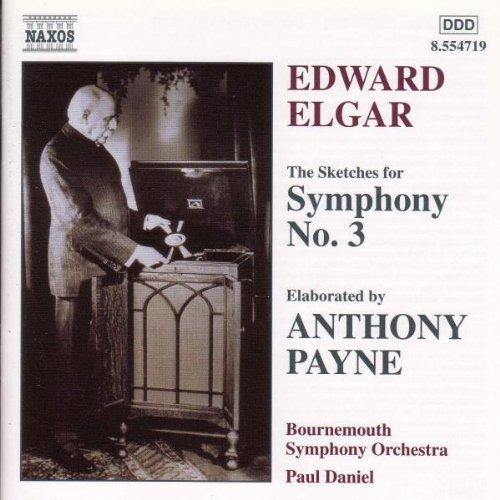Elgar-Payne Symphony 3
A truly memorable second commercial recording for Anthony Payne's masterly elaboration of Elgar's sketches, under one of Britain's brightest young conductors
View record and artist detailsRecord and Artist Details
Composer or Director: Edward Elgar
Genre:
Orchestral
Label: Naxos
Magazine Review Date: 3/2000
Media Format: CD or Download
Media Runtime: 55
Mastering:
DDD
Catalogue Number: 8554719

Tracks:
| Composition | Artist Credit |
|---|---|
| Symphony No. 3 |
Edward Elgar, Composer
Bournemouth Symphony Orchestra Edward Elgar, Composer Paul Daniel, Conductor |
Author: Andrew Achenbach
How thrillingly urgent Elgar's unforgettably gaunt introductory bars sound here - a magnificent launch-pad for an interpretation of unswerving dedication, plentiful character and purposeful intelligence. Audibly galvanised by Paul Daniel's fervent direction, the Bournemouth orchestra responds with infectious eagerness, notable polish and, most important, all the freshness of new discovery, their strings leaner (and, dare I say it, hungrier) than those of Sir Andrew Davis's BBC SO.
In these newcomers' hands there's a rhythmic snap and athletic drive about the mighty opening movement that genuinely exhilarate. Where Davis perhaps scores over Daniel is in the spiritual, 'inner' dimension he brings to those ineffably beautiful bars at the start of the development section (from 6'33'', or the Poco meno mosso marking at bar 72 in Boosey & Hawkes's handsome study score). Come the succeeding Allegretto, and Daniel's approach is more urgent, less evocative (and, yes, perhaps a shade bluffer) than Davis's, though he does impart a delightful skip to that playful Poco piu mosso episode in G major from bar 78 (3'26''). By the way, in this same movement (in bar 108 or 4'34'') the solo viola's G sharp crotchet is now trilled - just one of a clutch of subtle emendations Payne has since incorporated into the score.
The anguished slow movement welds a penetrating textural and harmonic clarity to a noble strength that I find very moving. Best of all is the finale, which now emerges in a rather less piecemeal fashion than it does under Davis. I particularly like the dark swagger Daniel locates in both those nobilmente paragraphs beginning at bars 68 and 253 (2'36'' and 10'01'' respectively), while the closing bars are magical, the final soft tam-tam stroke disappearing into the ether like some vast unanswered question. Tony Faulkner's sound is excellent in every respect, superbly focused and boasting an immensely satisfying spatial spread (with Daniel's antiphonally divided first and second fiddles especially well captured).
In sum, another Elgar jewel in the Naxos crown to set alongside Sir Edward Downes's magisterial interpretation of the Second Symphony (6/94). An issue absolutely not to be missed.'
In these newcomers' hands there's a rhythmic snap and athletic drive about the mighty opening movement that genuinely exhilarate. Where Davis perhaps scores over Daniel is in the spiritual, 'inner' dimension he brings to those ineffably beautiful bars at the start of the development section (from 6'33'', or the Poco meno mosso marking at bar 72 in Boosey & Hawkes's handsome study score). Come the succeeding Allegretto, and Daniel's approach is more urgent, less evocative (and, yes, perhaps a shade bluffer) than Davis's, though he does impart a delightful skip to that playful Poco piu mosso episode in G major from bar 78 (3'26''). By the way, in this same movement (in bar 108 or 4'34'') the solo viola's G sharp crotchet is now trilled - just one of a clutch of subtle emendations Payne has since incorporated into the score.
The anguished slow movement welds a penetrating textural and harmonic clarity to a noble strength that I find very moving. Best of all is the finale, which now emerges in a rather less piecemeal fashion than it does under Davis. I particularly like the dark swagger Daniel locates in both those nobilmente paragraphs beginning at bars 68 and 253 (2'36'' and 10'01'' respectively), while the closing bars are magical, the final soft tam-tam stroke disappearing into the ether like some vast unanswered question. Tony Faulkner's sound is excellent in every respect, superbly focused and boasting an immensely satisfying spatial spread (with Daniel's antiphonally divided first and second fiddles especially well captured).
In sum, another Elgar jewel in the Naxos crown to set alongside Sir Edward Downes's magisterial interpretation of the Second Symphony (6/94). An issue absolutely not to be missed.'
Discover the world's largest classical music catalogue with Presto Music.

Gramophone Digital Club
- Digital Edition
- Digital Archive
- Reviews Database
- Full website access
From £8.75 / month
Subscribe
Gramophone Full Club
- Print Edition
- Digital Edition
- Digital Archive
- Reviews Database
- Full website access
From £11.00 / month
Subscribe
If you are a library, university or other organisation that would be interested in an institutional subscription to Gramophone please click here for further information.




